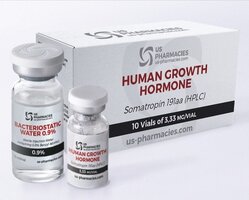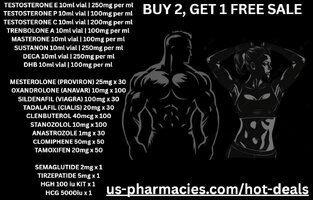- Joined
- Apr 9, 2024
- Messages
- 1,340
- Reaction score
- 6,039
- Points
- 121
Human Growth Hormone (HGH) is a peptide hormone produced by the pituitary gland. It stimulates
growth, cell reproduction, and regeneration. In performance enhancement, HGH is valued for its
potential benefits on body composition, recovery, and overall physiology. This guide synthesizes
evidence-based protocols and expert recommendations, focusing on safe, effective, and
health-conscious approaches.
Key Functions of HGH
• Stimulates growth in children and adolescents
• Increases protein synthesis in muscle and bone
• Promotes fat breakdown (lipolysis)
• Contributes to glucose regulation
• Supports immune function
• Aids in recovery and tissue repair
• Influences cellular regeneration
Natural HGH Production
Peak production during puberty, then declines ~10% per decade after age 30. By age 60, most people
produce ~75% less HGH than in their 20s.
Enhancing Factors: Quality deep sleep, intense exercise, intermittent fasting, reduced insulin, good
nutrition.
Suppressing Factors: Poor sleep, excess body fat, chronic stress, aging.
Benefits of HGH
Performance:
• Faster recovery
• Increased lean muscle
• Stronger tendons/joints
• Lower body fat
• Improved exercise capacity
Health:
• Better immunity
• Improved skin elasticity
• Better sleep
• Faster injury healing
• Cognitive benefits
Mechanisms of Action
Direct Effects: Fat breakdown, reduced insulin sensitivity, muscle protein retention, increased glucose
output, sodium retention.
Indirect Effects (via IGF-1): Bone/cartilage growth, cellular proliferation, neuronal protection, organ
maintenance.
GH/IGF-1 Axis: Pituitary → GH → Liver → IGF-1 → Tissue effects.
Local vs Systemic IGF-1
• Systemic IGF-1: Liver-derived, measurable in blood, broad effects.
• Local IGF-1: Produced in muscles/tissues, not measurable, crucial for hypertrophy.
Serum IGF-1 is a proxy, but muscle growth depends more on local IGF-1.
Practical Application
1. Nighttime dosing aligns with natural pulses.
2. Training window boosts HGH sensitivity.
3. Track both serum IGF-1 and performance.
4. Consistency is key.
Metabolic Effects
HGH impacts glucose, protein, and fat metabolism as well as water balance.
Hormone Interactions
Testosterone: Synergistic with HGH; estrogen from T aids GH → IGF-1 conversion.
Insulin: Opposing metabolic effects but enhances IGF-1 production. Balance required.
Optimal Protocols
Anti-Aging: 1–2 IU daily, AM or bedtime, ongoing.
Body Composition: 3–6 IU daily, 3–6 months cycle, maintenance 1–2 IU.
Bodybuilding: 6–10+ IU daily, 3–6 months cycle, maintenance phase.
Titration: Start 2 IU, increase slowly by 1 IU every 2–3 weeks.
Administration
• Subcutaneous injection: preferred, less painful, effective.
• Intramuscular injection: faster absorption, more painful.
Sites: Abdomen, thighs, love handles.
Duration & Cycling
• Short term (2–3 months): cosmetic/recovery benefits.
• Long term (6+ months): body composition, hypertrophy, anti-aging.
Continuous use with maintenance dosing (1–2 IU) is preferred.
Monitoring
Bloodwork every 8–12 weeks: IGF-1, glucose, insulin, A1C, lipids, CBC, thyroid, kidney.
Tracking: Weight, photos, recovery, endurance, sleep, side effects.
Risks & Side Effects
Common: Water retention, joint pain, carpal tunnel, insulin resistance, headaches.
Serious (high dose/long term): Acromegaly, diabetes risk, tumor growth risk, heart enlargement.
Best Practices
1. Optimize testosterone first.
2. Start low, titrate slowly.
3. Use nighttime dosing if >3 IU.
4. Track IGF-1 and subjective performance.
5. Maintain at 2–4 IU long-term.
6. Prioritize health monitoring.

growth, cell reproduction, and regeneration. In performance enhancement, HGH is valued for its
potential benefits on body composition, recovery, and overall physiology. This guide synthesizes
evidence-based protocols and expert recommendations, focusing on safe, effective, and
health-conscious approaches.
Key Functions of HGH
• Stimulates growth in children and adolescents
• Increases protein synthesis in muscle and bone
• Promotes fat breakdown (lipolysis)
• Contributes to glucose regulation
• Supports immune function
• Aids in recovery and tissue repair
• Influences cellular regeneration
Natural HGH Production
Peak production during puberty, then declines ~10% per decade after age 30. By age 60, most people
produce ~75% less HGH than in their 20s.
Enhancing Factors: Quality deep sleep, intense exercise, intermittent fasting, reduced insulin, good
nutrition.
Suppressing Factors: Poor sleep, excess body fat, chronic stress, aging.
Benefits of HGH
Performance:
• Faster recovery
• Increased lean muscle
• Stronger tendons/joints
• Lower body fat
• Improved exercise capacity
Health:
• Better immunity
• Improved skin elasticity
• Better sleep
• Faster injury healing
• Cognitive benefits
Mechanisms of Action
Direct Effects: Fat breakdown, reduced insulin sensitivity, muscle protein retention, increased glucose
output, sodium retention.
Indirect Effects (via IGF-1): Bone/cartilage growth, cellular proliferation, neuronal protection, organ
maintenance.
GH/IGF-1 Axis: Pituitary → GH → Liver → IGF-1 → Tissue effects.
Local vs Systemic IGF-1
• Systemic IGF-1: Liver-derived, measurable in blood, broad effects.
• Local IGF-1: Produced in muscles/tissues, not measurable, crucial for hypertrophy.
Serum IGF-1 is a proxy, but muscle growth depends more on local IGF-1.
Practical Application
1. Nighttime dosing aligns with natural pulses.
2. Training window boosts HGH sensitivity.
3. Track both serum IGF-1 and performance.
4. Consistency is key.
Metabolic Effects
HGH impacts glucose, protein, and fat metabolism as well as water balance.
Hormone Interactions
Testosterone: Synergistic with HGH; estrogen from T aids GH → IGF-1 conversion.
Insulin: Opposing metabolic effects but enhances IGF-1 production. Balance required.
Optimal Protocols
Anti-Aging: 1–2 IU daily, AM or bedtime, ongoing.
Body Composition: 3–6 IU daily, 3–6 months cycle, maintenance 1–2 IU.
Bodybuilding: 6–10+ IU daily, 3–6 months cycle, maintenance phase.
Titration: Start 2 IU, increase slowly by 1 IU every 2–3 weeks.
Administration
• Subcutaneous injection: preferred, less painful, effective.
• Intramuscular injection: faster absorption, more painful.
Sites: Abdomen, thighs, love handles.
Duration & Cycling
• Short term (2–3 months): cosmetic/recovery benefits.
• Long term (6+ months): body composition, hypertrophy, anti-aging.
Continuous use with maintenance dosing (1–2 IU) is preferred.
Monitoring
Bloodwork every 8–12 weeks: IGF-1, glucose, insulin, A1C, lipids, CBC, thyroid, kidney.
Tracking: Weight, photos, recovery, endurance, sleep, side effects.
Risks & Side Effects
Common: Water retention, joint pain, carpal tunnel, insulin resistance, headaches.
Serious (high dose/long term): Acromegaly, diabetes risk, tumor growth risk, heart enlargement.
Best Practices
1. Optimize testosterone first.
2. Start low, titrate slowly.
3. Use nighttime dosing if >3 IU.
4. Track IGF-1 and subjective performance.
5. Maintain at 2–4 IU long-term.
6. Prioritize health monitoring.






